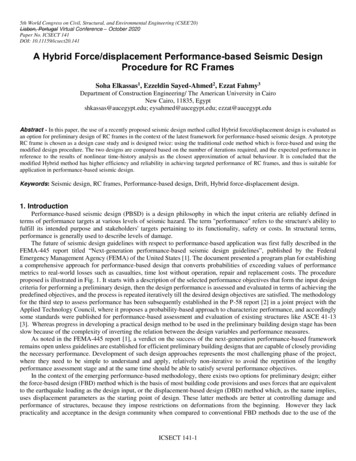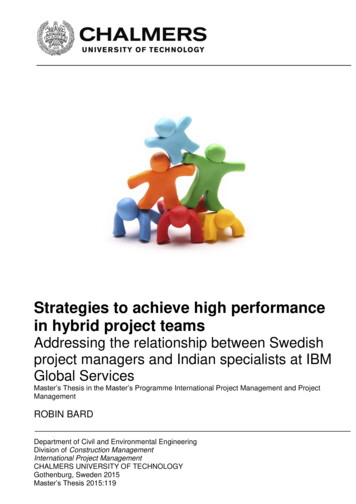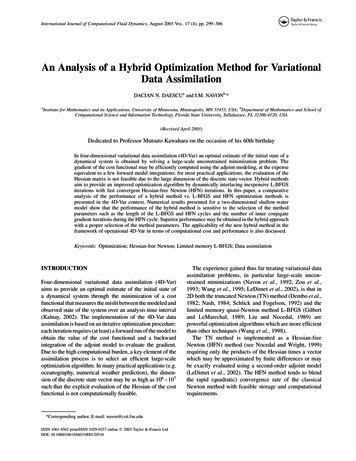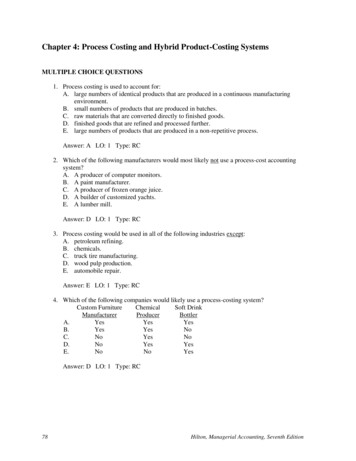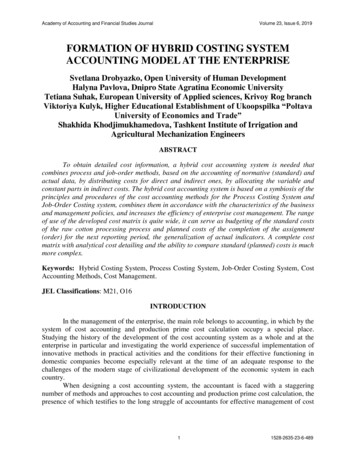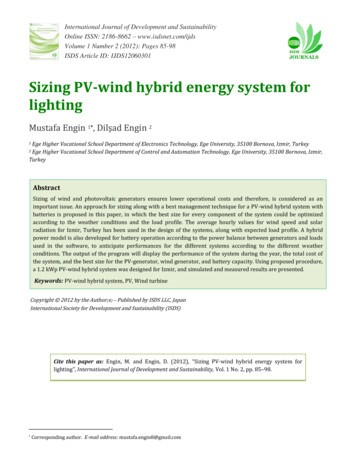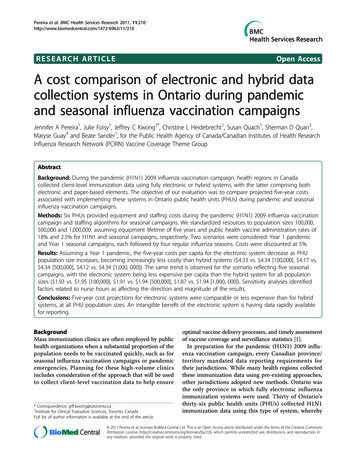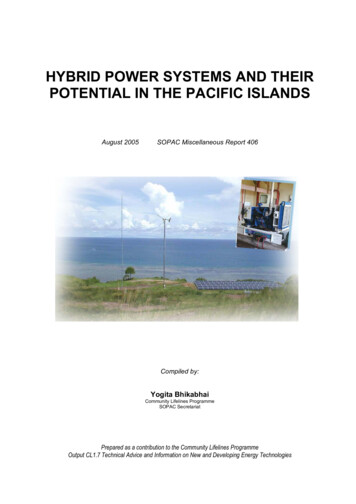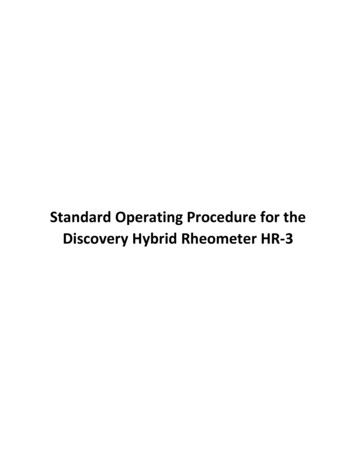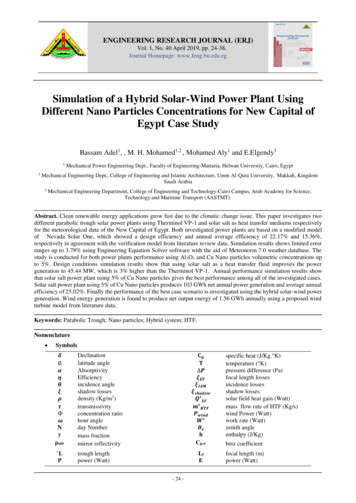
Transcription
ENGINEERING RESEARCH JOURNAL (ERJ)Vol. 1, No. 40 April 2019, pp. 24-38.Journal Homepage: www.feng.bu.edu.egSimulation of a Hybrid Solar-Wind Power Plant UsingDifferent Nano Particles Concentrations for New Capital ofEgypt Case StudyBassam Adel1, , M. H. Mohamed1,2 , Mohamed Aly1 and E.Elgendy312Mechanical Power Engineering Dept., Faculty of Engineering-Mattaria, Helwan University, Cairo, EgyptMechanical Engineering Dept., College of Engineering and Islamic Architecture, Umm Al-Qura University, Makkah, KingdomSaudi Arabia3Mechanical Engineering Department, College of Engineering and Technology-Cairo Campus, Arab Academy for Science,Technology and Maritime Transport (AASTMT(Abstract. Clean renewable energy applications grow fast due to the climatic change issue. This paper investigates twodifferent parabolic trough solar power plants using Therminol VP-1 and solar salt as heat transfer mediums respectivelyfor the meteorological data of the New Capital of Egypt. Both investigated power plants are based on a modified modelof Nevada Solar One, which showed a design efficiency and annual average efficiency of 22.17% and 15.36%,respectively in agreement with the verification model from literature review data. Simulation results shows limited errorranges up to 3.78% using Engineering Equation Solver software with the aid of Meteonorm 7.0 weather database. Thestudy is conducted for both power plants performance using Al 2O3 and Cu Nano particles volumetric concentrations upto 5%. Design conditions simulation results show that using solar salt as a heat transfer fluid improves the powergeneration to 45.44 MW, which is 3% higher than the Therminol VP-1. Annual performance simulation results showthat solar salt power plant using 5% of Cu Nano particles gives the best performance among all of the investigated cases.Solar salt power plant using 5% of Cu Nano particles produces 103 GWh net annual power generation and average annualefficiency of 25.02%. Finally the performance of the best case scenario is investigated using the hybrid solar-wind powergeneration. Wind energy generation is found to produce net output energy of 1.56 GWh annually using a proposed windturbine model from literature data.Keywords: Parabolic Trough; Nano particles; Hybrid system; HTF.Nomenclature Symbols𝜹 titude angleAbsorptivityEfficiencyincidence angleshadow lossesdensity (Kg/m3)transmissivityconcentration ratiohour angleday Numbermass fractionmirror reflectivity LPtrough lengthpower (Watt)𝐂𝐩𝐓 ��𝒐𝒘𝑸 𝑺𝑭𝒎 𝑯𝑻𝑭𝑷𝒘𝒊𝒏𝒅𝑾 𝜽𝒛hCp,wLfE- 24 -specific heat (J/Kg. K)temperature ( K)pressure difference (Pa)focal length lossesincidence lossesshadow lossessolar field heat gain (Watt)mass flow rate of HTF (Kg/s)wind Power (Watt)work rate (Watt)zenith angleenthalpy (J/Kg)betz coefficientfocal length (m)power (Watt)
Engineering Research Journal (ERJ) ORClow pressure turbinehigh pressure turbineintergovernmental panelchangeorganic Rankine Flevelized cost of energyphoto-voltaicdirect normal irradiationconcentrated solar power plantsparabolic trough collectordirect steam generationheat transfer fluidSMHAWTVAWTMWCNTHITECHITEC XLDUKETESEESASPENthermal energy storageengineering equation Solversimulation toolAPROSAZTRAKactive construction centersandia national laboratoryfinite volume methodpart per millionMonte Carlo Ray-Tracesolar multiplehorizontal axis wind turbinevertical axis wind turbinemulti-walled carbon nanoNaNO3 NaNO2 KNO3modified HITECDurchlaufkonzept Entwicklungund Erprobungsimulation toolrotation platform at SNLSubscriptsambElecsfHTFRecOverIAM1.Vol. 1, No. 40 April 2019, pp. 24-38AcronymsLPTHPTIPCC Bassam Adel et al.Ambientelectricalsolar fieldFluidReceiverOverallincidence angle base fluidconcentrationthermalnano-fluidsolar saltIsentropicreliability and even social interface. S. Dihrab and K.Sopian [6] developed a mathematical model to predictthe monthly average power generation over threedifferent locations in Iraq by a PV-wind hybrid System.The DNI was found to be the most effective parameterthat contributes to higher power generation.The anthropogenic greenhouse gas concentration andglobal average of temperature were recorded by theIPCC 2007 [1] to reach their peak value with a dramaticincrease to about 390 ppm (39% increase compared tothe pre-industrial records and 0.76 increase in Earth’saverage of temperature. Many internationalorganizations predicted that the current levels of CO2emissions would lead into 2 increase of earth’stemperature [1] and about 450 ppm for CO 2 emission.UN members signed the Climate Change Agreement inParis 2015 [2] to maintain the temperature of the earthand CO2 emissions within their acceptable level. Earthreceives about 1.8 1011 GW of energy from the sun.Therefore, the current demand from the world’s energyis about only 1% of this amount [3]. Clean renewableenergy resources are the main scope of most powergeneration studies with their different application.In this paper, the main study is solar energy productionusing PTC which is shaped in the form of parabolic glassmirror and a focal line positioned at a long tubeabsorber. This technology could be used in DSG toproduce Steam directly S. Ravelli et. al [7] and then theparabolic trough collector solar field, is considered to beRankine cycle boiler as implemented in Almeria powerplant. Mario Biencinto et. al. [8] also investigated theperformance of PTC mathematical model usingTRNSYS with two different modes of controlling thesteam pressure of a DSG 38.5 MW power plantconcluding that the variable pressure regulation strategyis more efficient through the entire power generationprocess.Powell et. al. [4] reviewed most commonly used hybridsolar energy systems implemented worldwide orsuggested by researchers using bio-mass, fuel fired backup, ORC and wind energy. They showed theiradvantages based on efficiency, economy, reliabilityand LCOE in a comparative study. Al-Falahi et. al. [5]reviewed the most modern applied system for rural areasand location; in addition to reviewing the modern trendsin software tools used to predict their performance. PVWind-Diesel hybrid back-up system was found to be themost frequent choice for this application based onmetrological and economic factors, load profile,The CSP technology uses a heat transfer fluid whichhave specific technical thermo-physical properties, suchas Therminol VP-1 and other Therminol types, Sylthrem800 and Dowtherm A. The heat absorbed by the solarfield transfers to the HTF which exchanges heat with thesteam used to run the Rankine cycle. A part of energycan be stored in a TES to supply heat to the power plantduring the night time hours or cloudy periods. Zarza et.al. [9] developed a mathematical model to investigatethe performance of Sevilla 5 MW DSG power plant. The- 25 -
Engineering Research Journal (ERJ)Bassam Adel et al.study concluded that system optimized operationaltemperature is about (260 300 C ) from the cost pointof view. Feldhoff et. al [10] investigated the new PTCtechnologies during the DUKE project. The newcollectors were designed to have better opticalefficiency about 77% and showed low rates of heatlosses which led to larger energy supply into the powerblock as well.Vol. 1, No. 40 April 2019, pp. 24-38used in AZTRAK operated by SNL using FVM andMCRT methods; they concluded that Therminol andSylthrem 800 have better thermal performance overHITEC XL and solar salt from the first law ofthermodynamics analysis point of view. D. Bishoyi andK. Sudhakar [19] suggested a PTC solar power plantusing HITEC as a HTF for an output power of 100 MWin Rajastan, India. Simulation results showed that theoverall solar-to-electric efficiency could reach to 21%and 285 GWh of output electrical power.F. Trieb et. al. [11] developed a simulation code usingEES to simulate the performance of many implementedsolar power plants in different locations with differentPTC types, LS-2, LS-3 and Fresnel using EESmathematical model for different PTC and power. Theyinvestigated the performance of each PTC solar powerplant for different condenser cooling methods. Theyproposed a simplified equivalent schematic layout foreach power plant for different meteorological datathrough the simulation procedure. I. L. Garcia et. al. [12]investigated the performance of 50 MW Andasol powerplant which is equipped by a TES to supply heat duringnight hours. The simulation was carried out to study theinstantaneous performance of the power plant usingEES and the true data supplied by ACS. Y. Li, Y. Yanginvestigated the coexistence of TES using ASPEN plusmodel through different solar multiple (SM) rangesvaried from (1.1 1.5). They concluded that increasingthe SM factor will increase the power generation,however the LCOE will increase as well. The resultsshowed that the best-case scenario to be (SM 1.2) [13]from the Thermo-economic point of view. W. Al-Malikiet. al [14] investigated the performance of 50 MWAndasol solar power plant and compared the simulationdata with the recorded data by operator with acceptablerange of errors for the simulation data conducted byAPROS software.The HTF thermo-physical properties can be modifiedusing small concentrations of Nano-particles. Similar tothe applications implemented widely in many industriesof metal alloying, refrigeration, lubricants and oil. Nanoparticles offer a smart way to change the thermophysical properties of the medium. Many researchersdiscussed the effect of using Nano-particles additivesthrough the solar power plant thermal performance.Colongelo et. al. [20] investigated experimentally theeffect of Cu, CuO, ZnO and Al2O3 Nano particles on thebehavior of thermal conductivity of the Diathermic oil.Results showed that ZnO increases the thermalconductivity more than other Nano particles. AKasaeian et. al. [21] developed an experimental test rigcalled the pilot through collector (0.7m width) usingdifferent concentrations of MWCNT. Results showedthat 0.2% addition of MWCNT leaded into increasingsystem thermal efficiency by (4-5) % whereas 0.3%addition increased the system thermal efficiency to (57%).V. Ferrero et. al. [22] investigated the performance ofPTC using Synthetic oil as a HTF with differentconcentrations of Al2O3 Nano particles which resultedinto slightly increase in power generation but leadedinto increasing the parasitic pumping power as well. E.Bellos and T. Christos [23] developed a mathematicalmodel to investigate the power generation performancefor EU-150 PTC using Sylthrem 800 as a HTF by theaddition of Al2O3 and CuO Nano particles; the studyconcluded that both options leaded into increasing thesystem thermal efficiency. Chan Z. et. al. [24] alsoinvestigated the thermal conductivity of Diathermic oilbased on SiC Nano particles. Results showed that 0.8%addition of SiC Nano particle would increase thethermal conductivity by 7.36% but for lowerconcentrations the effect is slightly lean.The heat transfer fluid (solar field fluid) has a significantinfluence on the performance of the solar power plantsince the thermo-physical properties and the fluidchemical composition are the major affectingparameters through the calculation of the pumpingpower, hydraulic losses and the thermal model of thesolar power plant [15]. S. A. Kalogirou [16] developedan EES code to simulate the thermal circuit of theparabolic through absorber for steady state conditionswith different sets of modeling equations the researchconcluded that one dimensional model is simple andprovides acceptable range of errors during the study ofplant performance compared to the 3D thermal circuitmodel.Many researchers investigated the simulation ofdifferent PTC models using different simulation toolsand different mathematical models. Heat transfer fluidsplay an important role in the solar field performancesince a slight variation in their thermo-physicalproperties results in significantly large change in thethermal model of the solar field. The Nano particlescontribute into changing the thermo-physical propertiesof the heat transfer fluid without changing theirchemical composition to enhance the thermalperformance of the PTC power plant. The present workinvestigates two different PTC technologies to allow theuse of two different HTF with widely changingtemperature ranges. Then the case of pure HTF isE. Bellos et. al [17] discussed the performance of an EU150 PTC using 7 different fluids which are pressurizedwater, Therminol VP-1, nitrate molten salt (Known asbasic binary solar salt), Sodium liquid, air, CO2 andHelium under temperature ranges of (300 1300 K).Results showed that water gives the better performancefor temperature ranges lower than 550 K and CO2 is thebest solution for temperatures ranges over 1100 K ;whereas the liquid sodium shows the highest range ofexegetic performance. Z.D. Cheng et. al. [18]investigated the effect of different HTF over LS- PTC- 26 -
Engineering Research Journal (ERJ)Bassam Adel et al.compared to the addition of different Nano particlesconcentrations. Finally based on the best-case scenariothe hybrid wind-solar power generation system isinvestigated to compare those cases with the basic pureTherminol VP-1 stand-alone power plant. The studyuses EES mathematical model to predict the designpoint, annual and monthly performance.2.Vol. 1, No. 40 April 2019, pp. 24-38in Table [1]. Nevada Solar-One is a 75 MWe powerplant uses Therminol VP-1 as a HTF using EU-100 as aPTC model since Therminol VP-1 maximumoperational temperature is limited to 400 C [25] . Solarsalt can operate under temperature levels up to 600 C aselaborated in the next section of the paper so it usesHEMS08 as a PTC. HEMS08 PTC is implemented inArchimede solar power plant [27] which produces 5MWe of electric output power. It uses solar salt as a HTFlocated in Italy. Fig. (1) shows a schematic layout of theproposed
as Therminol VP-1 and other Therminol types, Sylthrem 800 and Dowtherm A. The heat absorbed by the solar field transfers to the HTF which exchanges heat with the steam used to run the Rankine cycle. A part of energy can be stored in a TES to supply heat to the power plant during the night time hours or cloudy periods. Zarza et. al. [9] developed a mathematical model to investigate the .


